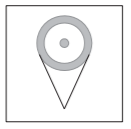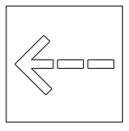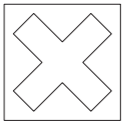4.76.10 Interpret information on aerodrome/heliport charts. AIP GEN & AIP Volume 4
Aerodrome/Heliport Charts include:
- Date effective
- ICAO location
- Elevation in ft
- Controlled airspace with vertical limits
- Co-ordinates
- Sector boundary of airspace,
- Natural high point with elevation
- Runway length and width
- Communications frequencies
- Controlled airspace with vertical limits
- Direction arrow
- VFR arrival and departure route
- Traffic circuits
- Any specific arrival / departure instructions
4.76.8 Describe the meaning of the various aerodrome ground signals.
AERODROME GROUND SIGNALS
 |
When displayed at a Parachute Landing Area (PLA), a red and white cone with the point of the cone pointing into wind indicates that the dropping area is active |
 |
A white Letter “A” indicates that agricultural operations or training operations are being conducted. These flight may not comply with the direction of the aerodrome circuit |
 |
An arrow formed of white fabric strips on the surface indicates that Gliding is in progress.
Gliders are landing and being towed off in the direction of the arrow.
Tow lines are likely to be on the ground at any distance from the towing source and on or parallel to the signal strips |
 |
White crosses displayed horizontally on the manoeuvring area indicate that the ground or portion of runway is unfit for use |
4.76.6 Describe the movement area of an aerodrome. CAR 1
Movement area means that part of an aerodrome intended to be used for;
the take-off and landing of aircraft and for the surface movement of aircraft,
and includes the manoeuvring area, maintenance areas, and aprons.
4.76.4 Describe the method of runway designation. AIP AD
The runway or strip designation is a two-digit number based on
the whole number nearest to one-tenth of the magnetic azimuth
of the centre line when viewed from the direction of approach, e.g. if the magnetic azimuth of strip is 208°M, the runway will be designated as RWY 21
4.76.2 Describe the limitations on the use of a place as an aerodrome or heliport. CAR 91
- Aerodrome must be suitable for the aircraft taking off or landing.
- Must comply with any limitations and operational conditions for the aerodrome
- If operating at night, operable lighting is available and activated
- Runway is clear of all persons, animals, vehicles, vessels, or other obstructions other than persons, vehicles, or vessels essential to the operation.
4.75.32 Interpret airspace information on aeronautical charts used for VFR flights.
On Aeronautical charts
- Control Zones (CTR) have blue solid line boundaries / Class of airspace in the CTR and CTR upper limit / CTR – lower limit (SFC) /Whether Transponder Mandatory
- Control Areas (CTAs) on aeronautical charts – Purple boundaries with solid line / Class of airspace in the CTA / upper and lower limits (SFC) / (SFC) / whether Transponder Mandatory
- Mandatory Broadcast Zone airspace on aeronautical charts – Boundary is shown by a blue dotted line / Designated by the letters MZB / followed by 3-digit number and a name followed by a designating letter / frequency to use and the time interval at which position reports must be transmitted
- VFR Transit Lanes on Aeronautical charts; Boundary is solid blue lines / Letter “T“] followed by a 3-digit figure and a name, The word “DAY” is added to emphasize transit lane availability is daytime only
- Restricted Areas airspace on aeronautical charts – Restricted area shown in red / NZR, followed by 3-digit number and a name plus the time during which the area is active
- Military Operating Zones airspace on aeronautical charts / Restricted area shown in red / NZM followed by 3-digit number / the time during which the area is active H24 means permanently active
- Volcanic Hazard Zone airspace on aeronautical charts – area shown in red with upper and lower limits / NZV, followed by 3-digit number / H24 means permanently active volcano
- Low Flying Zone airspace on aeronautical charts – Shown by thin blue lines / NZL followed by 3 digit number and a name / upper and lower limits given.
4.75.30 State the operating considerations relating to operating an aircraft over or close to temporary hazards/airspace. AIP ENR
Entry to a Temporary Hazard Zone can be authorised by the administering authority.
4.75.28 State the operating considerations relating to operating an aircraft in a common frequency zone (CFZ). AIP ENR
4.75.26 State the restrictions and operating considerations relating to operating an aircraft in a designated low flying zone (LFZ). CAR 91 & AIP ENR
- Low Flying Zones are restricted to pilots receiving dual instruction or hold Instructor Rating and have been authorised/ briefed on the boundaries and know the entry and exit method
-
In a low Flying Zone pilots must broadcast intentions and estimated time in the area before entering and report when vacating the area
-
In a Low Flying Zone you must maintain a continuous listening watch
-
Dual low flying can be conducted with visibility no less than 1500 metres and no passengers on board
4.75.24 State the restrictions and operating considerations relating to operating an aircraft in a danger area. CAR 91 & AIP ENR
- You can fly through a Danger Zone only after you have obtained all relevant information regarding its use and when you have satisfied yourself that aircraft safety will not be affected.